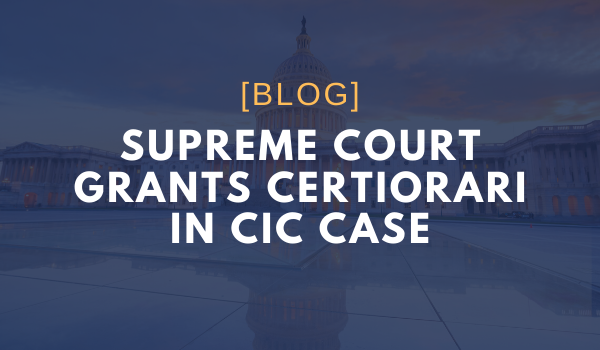On May 17, 2021, the United States Supreme Court issued its opinion in CIC Services, LLC v. Internal Revenue Service, a case challenging the legality of Notice 2016-66. In its opinion, the Court handed a victory to the captive insurance industry.
This is good news for the captive insurance industry. This case marks the first time that a court has ruled in favor of captive insurance and against the IRS.
Background
Notice 2016-66
On November 1, 2016, the Internal Revenue Service (IRS) issued Notice 2016-66, which identified certain “micro-captive transactions” as “transactions of interest”. A “transaction of interest” is one, which the IRS believes might have the potential for “tax avoidance”, but for which the IRS lacks sufficient information to make that determination. A taxpayer that participates in a micro-captive transaction is required to report its participation to the IRS by filing a form with the IRS – Form 8886 for taxpayers and Form 8918 for material advisors.
Under sections 6707 and 6707A of the Internal Revenue Code (Code), taxpayers and material advisors who fail to file the appropriate form are subject to substantial penalties – both civil and criminal. In addition, the Code deems that the civil penalties for noncompliance are treated as “tax penalties”. This is the crux of the lawsuit. Of course, criminal penalties are not “tax penalties” but include fines and incarceration.
The Lawsuit
Almost immediately upon promulgation of Notice 2016-66, CIC, a captive manager and a material advisor, brought a lawsuit to enjoin enforcement of the reporting obligations contained in the Notice. CIC claimed that the IRS violated the Administrative Procedure Act (APA) in promulgating the Notice and that, as a result, the Notice was invalid. The APA imposes certain notice and comment procedures on a governmental agency before a regulation can be issued. In addition, it prohibits an agency from taking action that is “arbitrary and capricious”.
The IRS moved to dismiss the lawsuit on the grounds that CIC’s lawsuit was barred by the Anti-Injunction Act, (section 7421(a) of the Code), which prohibits “any suit for the purpose of restraining the assessment or collection of any tax . . . in any court by any person”. The IRS argued that the true purpose of the lawsuit was to prevent the IRS from collecting a tax penalty imposed on a taxpayer or material advisor that failed to report its participation in a micro-captive transaction to the IRS.
CIC claimed that the purpose of the lawsuit was not to restrain the assessment or collection of a tax. After all, CIC had never violated the reporting requirements and, as a result, had been subjected to no penalties. CIC claimed that the reporting obligation, itself, imposed a significant burden on taxpayers and material advisors, separate and apart from the penalties for non-compliance. CIC claimed that cost of complying with the reporting obligation exceeded the tax penalties that would be imposed for non-compliance. As a result, the Anti-Injunction Act did not bar CIC’s lawsuit.
The District Court agreed with the IRS and granted its motion to dismiss. CIC appealed, and the United States Court of Appeals for the Sixth Circuit upheld the dismissal. CIC did not have an automatic right to appeal to the Supreme Court, so it filed a Petition for a Writ of Certiorari. The Supreme Court granted CIC’s Petition, and this opinion followed.
What Did the Supreme Court Do?
The Court, in a unanimous opinion by Justice Kagan, framed the issue as follows:
The issue here, most concretely stated, is whether the Anti-Injunction Act bars CIC’s suit complaining that Notice 2016-66’s reporting requirements violate the APA.
The Court then said that, if the purpose of the lawsuit was to restrain the assessment or collection of a tax, then the suit must be dismissed. However, if the purpose of the suit was something else, then it could go forward.
The problem for the Court was that there is a “downstream tax penalty” attached to the reporting requirements. If Notice 2016-66 simply imposed a reporting requirement, without a tax penalty for non-compliance, this would be an easy case. The Anti-Injunction Act would not prohibit the lawsuit. “A reporting requirement is not a tax; and a suit brought to set aside such a rule is not one to enjoin a tax’s assessment or collection. That is so even if the reporting rule will help the IRS bring in future tax revenue . . . “ However, failure to comply with the Notice’s reporting requirements does result in a tax penalty. Therefore, the question for the Court was whether the target of the lawsuit was the reporting requirements or the tax penalty.
The purpose of a lawsuit depends upon the relief requested. What is the plaintiff asking for? In this case, CIC claimed that the purpose was to void the Notice’s burdensome reporting obligations. It was not to enjoin the collection of any tax. After all, CIC had been complying with the reporting obligations, and no tax penalty was or could have been assessed. The IRS, of course, claimed that the real purpose of the lawsuit was to prevent the IRS from collecting the tax penalty. By seeking to invalidate the Notice, CIC was really seeking to enjoin the collection of the tax penalty, because, without the reporting requirement, there could be no tax penalty.
The Court found that the purpose of the lawsuit was to invalidate the reporting requirements of Notice 2016-16, not to enjoin the assessment or collection of a tax. The Court based its decision on three aspects of the regulatory scheme.
1. The Court found that Notice 2016-66 imposes “affirmative reporting obligations, inflicting costs separate and apart from the statutory tax penalty”. In other words, even without the tax penalty, the Notice imposed significant non-tax burdens on taxpayers and material advisors.
Simply stated, this suit attempts to get out from under the (non-tax) burdens of a (non-tax) reporting obligation.
The fact that a decision invalidating the reporting obligations of the Notice means that the IRS will never be able to assess a penalty for non-compliance with the reporting obligations does not turn the lawsuit into one to enjoin the assessment or collection of a tax.
2. The reporting obligations contained in Notice 2016-66 are “several steps removed” from the tax penalty. Before the tax penalty can be imposed, a taxpayer or material advisor would have to withhold the necessary information from the IRS, the IRS would have to determine that the taxpayer or material advisor had an obligation to provide the required information, and the IRS would have to impose the tax penalty for failure to file. The Court determined that this connection was too attenuated.
CIC stands nowhere near the cusp of tax liability: Between the upstream Notice and the downstream tax, the river runs long. So, it is again hard to characterize this suit’s purpose as enjoining a tax.
3. Finally, the Court noted that non-compliance with the reporting obligations of Notice 2016-66 could expose a taxpayer to criminal liability. The typical route for challenging a tax penalty – pay the penalty and file a claim for refund – is not workable for a taxpayer who is required to risk criminal prosecution for failure to file the necessary forms, which is a prerequisite for the imposition of the tax. Without the violation of the statute, there would be no penalty for the taxpayer to pay and seek a refund.
So the criminal penalties here practically necessitate a pre-enforcement, rather than a refund, suit – if there is to be a suit at all. And so too, those penalties necessitate a suit at eliminating the Notice, rather than the statutory tax penalty. Only an injunction against the Notice gives the taxpayer or advisor what it wants: relief from the obligation to report transactions. An injunction against the tax penalty would not do so. Because such an injunction would leave both the reporting duty and the criminal penalty untouched, the taxpayer or advisor would still have to accede to the Notice’s demands on pain of prison time. Small wonder that CIC’s complaint asks for an injunction against the Notice, not one against the tax penalty helping to enforce it.
For the foregoing reasons, the Court decided that the purpose of CIC’s lawsuit was not to restrain the assessment or collection of a tax. As a result, the Court reversed the decision of the Circuit Court and remanded the case for proceedings consistent with its opinion.
What Does This Mean?
What does it mean when the Court says, “proceedings consistent with this opinion”? The Court does not say. However, the case was initially dismissed by the district court without a trial. So, what the Court is saying is that CIC is entitled to a trial and entitled to present evidence that Notice 2016-66 was issued in violation of the APA. If CIC is successful in proving its case, Notice 2016-66 will become null and void.
This case is good news for the captive insurance industry, even though it has no direct, current effect on the industry. Even after this decision, taxpayers and material advisors participating in a micro-captive transaction still have to file the appropriate forms with the IRS. In addition, the decision was based on general principles of administrative law, rather than anything specific to the captive insurance industry.
However, it is good news for the industry, nonetheless. This case marks the first time that a court has ruled in favor of captive insurance and against the IRS. Let’s hope that this is the first of many.



